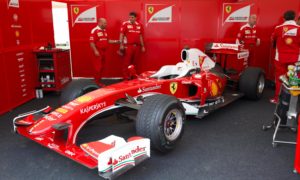While most of us were out shopping for presents and piling on the pounds over Christmas, David Coulthard was up in the hills around Monaco attempting to reduce his total body fat by another 2%!
Fitness is extremely important in Formula One as the driver’s body must be highly tuned and developed to withstand the stresses of driving for hours at a time in a cramped environment. Fatigue affects judgement and reflexes, so it’s not very helpful when racing a modern F1 car at speeds up to 200mph. David needs to be 100% focused for every inch he drives at every Grand Prix, and fitness is the key.
Drivers are much fitter today as they were ten years ago, now when a driver removes his helmet they have nothing but a few drops of sweat and crumpled hair to show for their exertion. This wasn’t always the case; in 1991 the great Ayrton Senna had to be helped from his car after winning the Brazilian Grand Prix for McLaren.
David learnt about fitness the hard way, “I had a problem with my back when I first started in F1” he admits. “After only my second race in 1994, I had such bad spasm and painful swelling in my left lower back that it ruptured the tissue around the muscle. Lying back that night after the race, I felt like I was lying on a bar of soap because it had swollen so much. Now we try to work hard on strengthening the lower back, the idea’s to do anything to keep it as supple as possible”.
At the start of the 1995 season, David still hadn’t learnt his lesson! “I didn’t start the season on a high. I’d cracked a rib at the Bercy end-of-season karting event in Paris and was unable to train for three weeks. Then things went from bad to worse with the tonsillitis. I just found I could do nothing after a race, and would take to my bed for a couple of days to recover”.
David believes that Michael Schumacher was the first driver to “take the fitness issue to new levels”. “A circuit like the Hungaroring is incredibly demanding and you can’t relax or you’ll spin off. I know because I’ve made my share of mistakes. Driving is a very uncomfortable job. I can’t think of any other sport to compare with F1. There’s just no rest in a Grand Prix car. For at least ninety minutes you’re at the wheel of a potentially lethal weapon and you cannot allow your concentration to waver for a second”.
DC also found the change from F3000 to F1 a shock, “Your upper body endurance must be strong enough to survive the stress of 5g, and when you brake at the end of a straight it feels like a sledgehammer has hit your back!”
This year the off-season was relatively short in comparison with recent years, but with a limit on the amount of testing the teams can do, David had more time to train. Just around the corner from his Monaco apartment lies an Olympic standard stadium, it is here that David uses the weight room in conjunction with an outdoor sports programme. David also uses the beautiful scenery around Monaco to do cycling, combining sprints with uphill climbs on the winding roads.
Other fitness activities include rock climbing, but to get there David has to trek while carrying his bike on his back! There is also basketball, which can help both balance and awareness, and bodyweight exercises on the beach that give DC a bit of variety in his training. This may all seem great fun, but it is just one part of a strict programme that aims for optimal physical fitness during the season.
The training also helps David to cope with jetlag and the tiredness experienced from back-to-back races and testing. There is also a psychological aspect of the training that increases David’s mental strength and character, this is done by completing the most rigorous training programme while overcoming the urge to stop.
Now David has started another season for McLaren he is fitter and stronger thanks to the training issued by his fitness trainer Jerry Powell, but what has it really done for him. “I feel a lot stronger. It may not be noticeable to those on the outside, but when you’re training you can see your body changing with muscle definition. We’re not out to be muscle men, but it’s good to work on a particular muscle, perhaps all the muscles in your shoulders and your back, see them develop and know they’re going to help when it comes to driving the car”.
In fact David and other Formula One drivers alike are remarkable, their resting pulse is just a mere 40 beats per minute and during periods of intense exertion this figure can go up to 196 beats per minute before coming back down to 48 after just five minutes! They can also recover much more quickly than most people as they utilize more than 70% of their lung capacity compared with our feeble 50%!
NB. This article was republished with the kind permission of the webmaster of the now defunct site DCSupporters.co.uk following requests from a number of our forum members for further articles on fitness in Formula One. The article was originally written in 2000-01, but we feel it is still relevant to modern day F1.








